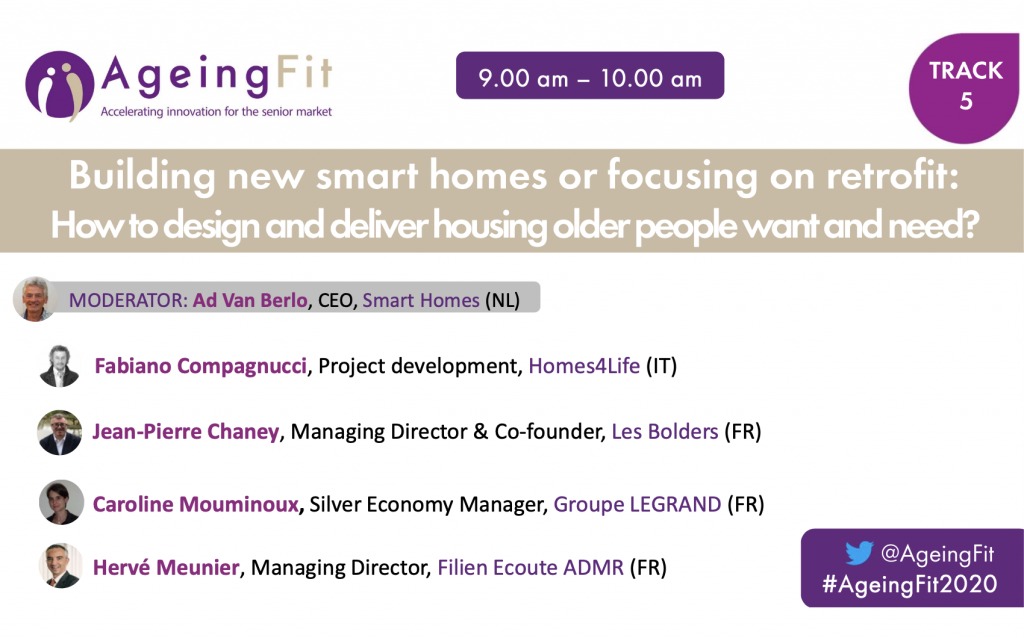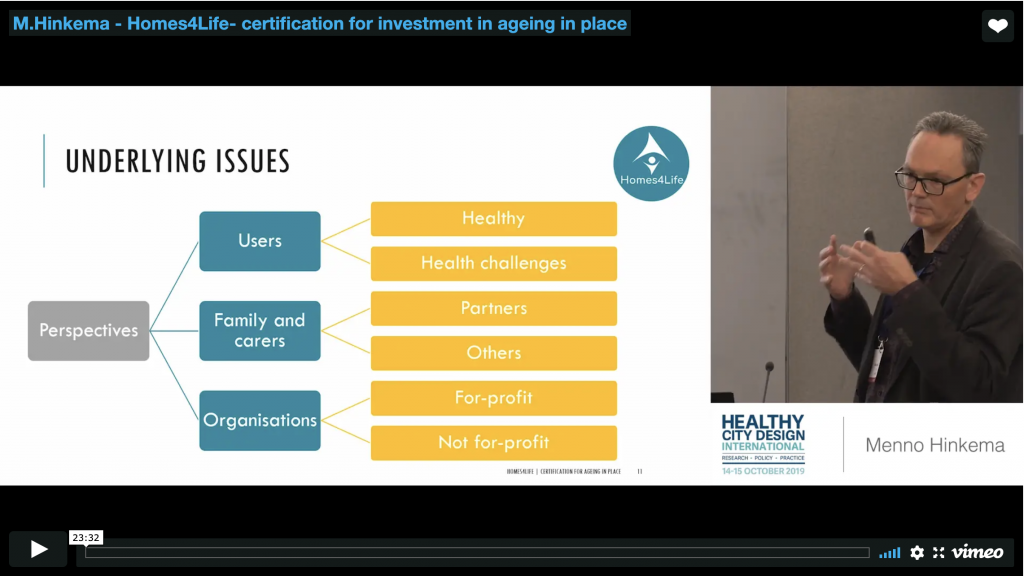Homes4Life Deliverable D2.1 – Desktop Research Report – is now available for download.

Executive Summary
Ensuring that our environments remain accessible for all ages is an urgent need as increasing life expectancies are making our societies more age diverse. The oldest members of our societies are an ever increasing group whose potential to contribute to our living together won’t be tapped unless we set in place the condition for independent living and participation for all society members, regardless of their age, and abilities. According to the World Health Organisation (WHO, 2017), housing is one of the three pillars composing age-friendly environments, along with accessible outdoor environments and transport and mobility. Because it is one of the places where we spend most time, especially after people retire, our homes can have a tremendous impact on our health and wellbeing, our social interactions, and our capacity to participate in community life.
At the present time though, a large part of homes and housing options in Europe are not fit for a wide range of users with specific needs and preferences. When living with a disability for instance, or when health declines and support needs arise, many people cannot find adequate solutions either to adapt their place, or to find an alternative option where they could remain autonomous while receiving the support they need. The present desktop research report is the result of this observation that this need to shift towards ageing-in-place does not yet, for many regions in Europe, coincide with adequate and sufficient solutions in the housing sector to meet the growing demand of older Europeans, the majority of whom want to age at home.
The report is based on the analysis of a series of reports depicting the situation in 10 European Member States: Austria, Belgium, Denmark, Spain, France, Ireland, Italy, the Netherlands, Poland and Sweden. Those countries have been selected to compose a sample as representative as possible of the diverse welfare systems and housing stocks existing in the European Union. They review existing statistics, scientific and grey literature in relation to socio-demographic trends, the situation of the housing stock, laws and policies for ageing-in-place and home adaptation (if any).
The report draws on a comparative analysis that is structured around three main sections, the first one reviewing our preferences in terms of housing as we age (Chapter 2), the second one states the cause of age-friendly housing based on the actual health, social and economic context (Chapter 3), and third section presents the legislative, policy, and housing contexts at national levels, that influence the likelihood of an age-friendly approach to arise in relation to housing (Chapter 4). The report then closes on four different scenarios representing potential routes for the future with 2040 as the horizon and the likeliness these scenarios present to adopt the Homes4Life certification scheme (Chapter 5).
Based on studies carried out in the 10 countries analysed for this desktop research report, a clear preference to remain living in their current home came out for older people. However, this possibility will only be made possible if their home can accompany and support this heterogeneous older population’s changing needs, lifestyles and abilities over time. It will also need to meet the different stages of their life and that of their possible cohabitants (partners, parents, children, house/flatmates, etc.). To enable them to satisfy their preference, there is an urgent need for a home that fosters people’s autonomy, as well as remaining active and healthy as they age, respects lifestyle choices, needs and preferences of people, regardless of their age across the life course, and enables accessibility to all areas of community life, thereby promoting inclusion and engagement. In other words, age-friendly homes.
The evolution of people’s preferences for their housing and home environment as they enter the so-called ‘fourth age’ and are more likely to become frail varies between reports and countries. In Austria (Austrian Interdisciplinary Platform on Ageing, 2015), it was found that the ‘oldest old’ (those aged between 80 and 85 years old) want to preserve their living situation – regardless of whether they are living in their private homes or in care settings. Only 5.6% of respondents in private households claimed they have played with the idea of giving up their own home and moving into a senior residence or a sheltered home. On the contrary in Denmark (Mathiasen N. et al, 2018), the desire to move is the highest among the ‘youngest’ old (those aged between 50 and 59 years of age) with one in three either preferring a smaller home or a more practical home. In this age category, only one in five wants to stay in their current home should they find it difficult to manage. This contrasts with a total of 64% of the 80-89-year olds who want to stay in their current home, even if they find it difficult to manage by themselves. Similarly, research in the Netherlands (Willem Gielen W. et al, 2018) showed that in recent years, a substantial increase was observed in the number of older adult households that are to a certain extent open to the idea of moving homes (i.e. they perhaps might consider it). This number has increased from 6% in 2009 to 16% in 2015.
Moving to another (usually smaller) place was considered as a possible option in several countries studied. These residential moves were considered for various situations: a change in family structures, a change in a financial situation, having an outstanding home loan, work-retirement transition, the death of a spouse, excessive housing costs, decline in health or inadequacy of current place (too far from commodities, too many stairs for people with mobility issues, too many risks of falls, etc.). However, according to Tatsiramos (Tatsiramos, 2006) who investigated residential mobility of older households in Europe, although homeowners are less likely to move compared to those who rent, older owners (above 65 years old) are significantly more likely to move in northern and central European, but not in the South2 and households with higher wealth holdings are more likely to move in all countries. This seems to indicate that ageing-in-place (in one’s current home) will continue to be the predominant norm for older people across Europe. The main difference being that in the North the rate of increase of owners who move and become renters is much higher compared to in the South. It is also important to highlight that regardless of the alternatives available for people when their current home becomes inappropriate, studies report that maintaining the links with the former community where one lived is key. In Ireland (Age-Friendly Ireland, 2016) for instance, 15% of those age 65 and over would be willing to move to a different home in their community. Similarly, in Sweden (Abramsson M., 2015), preferences tend to be “location”-dependent.
As stated in Council Resolutions and Conclusions, it is important to adopt an intersectoral health policies approach. It requires health systems to build up multi-sectorial collaboration
with other policy fields, such as transport, housing, environment in order to shape the social determinants of health (European Union, 2017 [a]). Indeed, according to the EU Ageing Report 2018, almost all Member States will face considerable continuous pressures on public spending from the health care sectors – even under conservative assumptions. Public health expenditure in EU28 was at 6.8 % of GDP in 2016. The projections show that expenditure may grow to 7.9 % of GDP in 2070 only on accounts of demographic ageing. Balancing the health care needs of the European populations with spending resources, as well as continuous efforts to increase the efficiency and quality of health service delivery, will continue to be high on the political and economic reform agenda of Member States (European Union, 2018). To realise this, there has been an ongoing transition of focus from cure to prevention. New models of care such as integrated care which emphasises a strengthened role for primary care are seen to be instrumental in enabling this necessary shift from disease orientation to a more person-centred focus. A supportive, accessible health care environment fostering integrated and more person-centred care will be aconducive environment for “ageing-in-place”, supporting older people to access primary care in the community where they live. It is expected that this transformation of health systems (away from hospital-based care) to more person-centred care will impact on housing and the need for their adaptation to facilitate this care delivery which will to a greater extent emphasise self-management and homecare.
Moreover, as people get older, it is more likely that their need for long-term care (LTC) will increase. LTC expenditure, similar as health care expenditure, represents an important and growing share of GDP and of health spending (public and total – including private). As is the case for health care, future trends are likely to be heavily influenced by population ageing as well as a range of non-demographic determinants. Therefore, public expenditure on LTC is therefore a relevant factor for the long-term sustainability of public finances. Important determinants of public expenditure on LTC largely depends on whether a country relies mainly on formal care or informal care and whether formal care is largely provided in institutions or at home. With more (formal) LTC delivered directly in older people’s own homes (instead of in residential and institutional care), to support informal carers, community and local policies will become increasingly important. Housing, both new and existing stock, will need to increasingly be designed to assist care professionals and informal carers in these care delivery tasks, as informal care forms a cornerstone of all long-term care (LTC) systems in Europe and is often seen as a cost- effective way of preventing institutionalisation and enabling users to remain at home (Zigante V., 2018).
Housing is thus an important social determinant of health and plays an active part in ageing-in-place. However, in order to adopt an intersectoral approach, it is important to understand the housing context and who are the stakeholders that can make a change. The actors involved in the provision of housing differ widely across Europe depending on how housing is planned and organised at regional or local levels, the laws and regulations governing who is responsible for housing supply and responsive planning, applicable building regulations, or other spatial planning laws that impact and influence our communities and living environments and the housing opportunities available to citizens (Andrews, D.,A. Caldera SánchezandÅ. Johansson, 2011). Nearly all governments intervene in housing markets, primarily for social and redistribution reasons (Andrews et al. 2011). Policy interventions include fiscal measures such as taxes and direct provision of social housing, as well as various regulations aimed at influencing housing market outcomes in terms of prices, rents, quantity, quality and allocation of dwellings (Caldera Sánchez A, Andrews D, 2011).
We can observe two different contexts in which policies to implement age-friendly housing have emerged and are being developed across the different countries: one with a strong public rental sector (Austria, Denmark, the Netherlands and Sweden) and one where home ownership dominates (Belgium, France, Ireland, Poland, Italy and Spain).
Countries with a strong rental sector usually have specific legal provisions in place that identify various housing associations that are responsible to ensure a sustainable supply of good quality and affordable dwellings to meet the different housing needs of their population. Given this housing’s public utility and social mission, one can observe systematic planning, evaluation and organisation of housing that responds to future needs in view of e.g. population ageing, migration, urban young people etc. This results in a public housing market that is more responsive. Moreover, rent regulations and rent controls in countries with a relatively large public rental sector appear to be comparatively strict compared to those favouring homeownership (Caldera Sánchez A, Andrews D, 2011). One can observe in all these countries a broad range of initiatives that can enable the development of age-friendly housing. In such countries, the main actors in age-friendly housing will be those organisations directly involved in the supply of this public rental stock. The actors differ from country to country, but generally some form of housing organisations; foundations; joint-stock companies; municipality housing companies etc – who due to their public utility mission are more strongly regulated and therefore generally a more responsive planning of housing to meet future needs including an ageing population. The following findings can be drawn from the country analysis for these countries:
- Specific planning and strategy for the housing supply at local levels based on a regulatory framework, including existing and affordable adapted mainstream housing options targeting older persons;
- High level of awareness within government about the need for age-friendly environment and housing, addressed in recent national plans, policies or research agendas in this field;
- Legal provisions, financial incentives and subsidies directed at both individuals but also large property owners to retrofit existing housing stock or build new mainstream housing targeting older persons; and
- Existing know-how e.g. official guidance at national level (handbooks, knowledge centres, national standards) about home adaptations for increased safety, and improved accessibility in the home.
On the other hand, countries where home ownership dominates, only a negligible part of the housing stock has a “public utility” mission or is subsidised, and the rental sector is on the open with less rent regulation. In these countries, one can see that the responsibility to ensure that housing meets the needs of the resident, therefore lies with the individual homeowners themselves. Municipalities may have various programmes to promote and encourage individuals who desire to adapt their home or property, rendering it more safe, accessible, and thus encouraging independent living. This is often done by providing grants directed at older people for home modifications to adapt existing housing. Given the lack of large-scale and a non-marginalised housing sector in these countries, most initiatives to develop age-friendly housing, can be considered as local and voluntary driven by a group of committed and interested individuals. Initiatives in these countries therefore tend to cater to private persons who can afford to invest in such age-friendly housing concepts. In such countries, private property companies and individuals (private homeowners or landlords) will be the main responsible investors in age-friendly housing. At local level, municipalities can also play a role by supporting and encouraging investment in age-friendly housing and ageing in place by subsidizing housing adaptation, grants to citizens who seek to adapt their homes and ensuring availability of long-term care services such as rehabilitation, homecare services, respite care etc.
Building on the country reports analysis presented in the previous chapters, the Homes4Life partners worked on four different scenarios framing different degrees of likeliness for age- friendly housing to develop. These scenarios are the result of a prospective exercise based on hypothetical combinations of parameters at local or national level. Those parameters form four different stereotypical contexts that influence the readiness and maturity levels for age-friendly housing to expand and ageing-in-place to become a reality. Exploring this question in light of today’s different national situations and trends that are foreseen for thecoming decades, we devised these four scenarios: The ‘frontrunner’; The ‘Happy Many’; The ‘Happy Few’; and the ‘lions’ den’.
Finally, for each of these scenarios, the likeliness of stakeholders to adopt the Homes4Life certification scheme is subject to three influential factors: (i) the existence or absence of binding legislation or incentives to support the development of age-friendly housing – be it through the availability of policy frameworks, technical guidelines, grants or tax credits, (ii) the main owners of the housing stock and ultimately, the stakeholders responsible for retrofitting dwellings or their new construction, (iii) the financial capacity of the owners to fund initiatives to retrofit housing or invest in new constructions supporting age-friendliness.


 The Research Institute of the
The Research Institute of the 




 The construction sector has a huge role to play in making our world sustainable, not only because it represents a large part of our physical environment, but because it is an industry that impacts all areas of society.
The construction sector has a huge role to play in making our world sustainable, not only because it represents a large part of our physical environment, but because it is an industry that impacts all areas of society.


